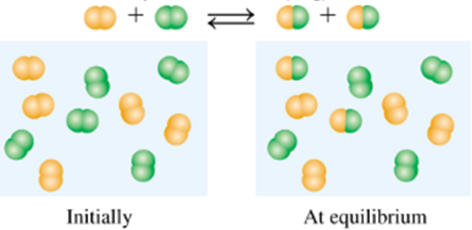
General, Organic, and Biological Chemistry: Structures of Life (5th Edition)
5th Edition
ISBN: 9780321967466
Author: Karen C. Timberlake
Publisher: PEARSON
expand_more
expand_more
format_list_bulleted
Concept explainers
Question
Chapter 10, Problem 10.42UTC
Interpretation Introduction
Interpretation:
‘Value of equilibrium constant is larger or smaller’ should be identified.
Concept introduction:
Equilibrium is the condition at which the rate of formation of product is equal to rate of disappearance of reactant.
Equilibrium constant is the concentration of product raise to its molecular coefficient divided to the concentration of reactant raise to its molecular coefficient, pure solids and liquids are not included in the equilibrium constant expression. and shown as below:
Given:

Expert Solution & Answer
Want to see the full answer?
Check out a sample textbook solution
Students have asked these similar questions
Help fix my arrows please
no Ai walkthroughs
Given the data attached, provide a drawing of the corresponding structure.
Chapter 10 Solutions
General, Organic, and Biological Chemistry: Structures of Life (5th Edition)
Ch. 10.1 - What is meant by the rate of a reaction? Why does...Ch. 10.1 - How does a catalyst affect the activation energy?...Ch. 10.1 - Prob. 10.3QAPCh. 10.1 - Prob. 10.4QAPCh. 10.1 - Prob. 10.5QAPCh. 10.1 - Prob. 10.6QAPCh. 10.2 - Prob. 10.7QAPCh. 10.2 - Prob. 10.8QAPCh. 10.2 - Prob. 10.9QAPCh. 10.2 - Prob. 10.10QAP
Ch. 10.2 - Prob. 10.11QAPCh. 10.2 - Prob. 10.12QAPCh. 10.3 - Prob. 10.13QAPCh. 10.3 - Prob. 10.14QAPCh. 10.3 - Prob. 10.15QAPCh. 10.3 - Prob. 10.16QAPCh. 10.3 - Prob. 10.17QAPCh. 10.3 - Prob. 10.18QAPCh. 10.3 - Prob. 10.19QAPCh. 10.3 - Prob. 10.20QAPCh. 10.4 - Prob. 10.21QAPCh. 10.4 - Prob. 10.22QAPCh. 10.4 - Prob. 10.23QAPCh. 10.4 - Prob. 10.24QAPCh. 10.4 - Prob. 10.25QAPCh. 10.4 - Prob. 10.26QAPCh. 10.4 - Prob. 10.27QAPCh. 10.4 - The Kc for the following reaction at 225C is...Ch. 10.5 - Prob. 10.29QAPCh. 10.5 - Ammonia is produced by reacting nitrogen gas and...Ch. 10.5 - Prob. 10.31QAPCh. 10.5 - Prob. 10.32QAPCh. 10.5 - Prob. 10.33QAPCh. 10.5 - Prob. 10.34QAPCh. 10.5 - Prob. 10.35QAPCh. 10.5 - Prob. 10.36QAPCh. 10.5 - Prob. 10.37QAPCh. 10.5 - Prob. 10.38QAPCh. 10 - Prob. 10.39UTCCh. 10 - Prob. 10.40UTCCh. 10 - Prob. 10.41UTCCh. 10 - Prob. 10.42UTCCh. 10 - Prob. 10.43UTCCh. 10 - Prob. 10.44UTCCh. 10 - Prob. 10.45AQAPCh. 10 - For each of the following changes at equilibrium,...Ch. 10 - Prob. 10.47AQAPCh. 10 - Prob. 10.48AQAPCh. 10 - Consider the reaction: (10.3) 2NH3gN2g+3H2g a...Ch. 10 - Consider the reaction: (10.3) 2SO2g+O2g2SO3g a...Ch. 10 - Prob. 10.51AQAPCh. 10 - Prob. 10.52AQAPCh. 10 - According to Le Châtelier’s principle, does the...Ch. 10 - Prob. 10.54AQAPCh. 10 - Prob. 10.55AQAPCh. 10 - Prob. 10.56AQAPCh. 10 - Prob. 10.57CQCh. 10 - Prob. 10.58CQCh. 10 - Prob. 10.59CQCh. 10 - Prob. 10.60CQCh. 10 - Prob. 10.61CQCh. 10 - Prob. 10.62CQCh. 10 - Prob. 10.63CQCh. 10 - Indicate if you would increase or decrease the...
Knowledge Booster
Learn more about
Need a deep-dive on the concept behind this application? Look no further. Learn more about this topic, chemistry and related others by exploring similar questions and additional content below.Similar questions
- help 20arrow_forwardProvide the drawing of the unknown structure that corresponds with this data.arrow_forward20.44 The Diels-Alder reaction is not limited to making six-membered rings with only car- bon atoms. Predict the products of the following reactions that produce rings with atoms other than carbon in them. OCCH OCCH H (b) CH C(CH₂)s COOCH མ་ནས་བ (c) N=C H -0.X- (e) H C=N COOCHS + CH2=CHCH₂ →→arrow_forward
- 3) Draw a detailed mechanism and predict the product of the reaction shown? 1) EtMgBr 2) H3O+arrow_forwardHow to draw the mechanism for this reaction?arrow_forward> H₂C=C-CH2-CH3 B. H₂O Pt C. + H2 + H₂O H D. 16. Give the IUPAC name for each of the following: B. Cl Cl c. Cl Cl 17. Draw the line-angle formula for each of the following compounds: 1. phenol 2. 1,3-dichlorobenzene 3. 4-ethyltoluene < Previous Submit Assignment Next ▸arrow_forward
arrow_back_ios
SEE MORE QUESTIONS
arrow_forward_ios
Recommended textbooks for you
 ChemistryChemistryISBN:9781305957404Author:Steven S. Zumdahl, Susan A. Zumdahl, Donald J. DeCostePublisher:Cengage Learning
ChemistryChemistryISBN:9781305957404Author:Steven S. Zumdahl, Susan A. Zumdahl, Donald J. DeCostePublisher:Cengage Learning ChemistryChemistryISBN:9781259911156Author:Raymond Chang Dr., Jason Overby ProfessorPublisher:McGraw-Hill Education
ChemistryChemistryISBN:9781259911156Author:Raymond Chang Dr., Jason Overby ProfessorPublisher:McGraw-Hill Education Principles of Instrumental AnalysisChemistryISBN:9781305577213Author:Douglas A. Skoog, F. James Holler, Stanley R. CrouchPublisher:Cengage Learning
Principles of Instrumental AnalysisChemistryISBN:9781305577213Author:Douglas A. Skoog, F. James Holler, Stanley R. CrouchPublisher:Cengage Learning Organic ChemistryChemistryISBN:9780078021558Author:Janice Gorzynski Smith Dr.Publisher:McGraw-Hill Education
Organic ChemistryChemistryISBN:9780078021558Author:Janice Gorzynski Smith Dr.Publisher:McGraw-Hill Education Chemistry: Principles and ReactionsChemistryISBN:9781305079373Author:William L. Masterton, Cecile N. HurleyPublisher:Cengage Learning
Chemistry: Principles and ReactionsChemistryISBN:9781305079373Author:William L. Masterton, Cecile N. HurleyPublisher:Cengage Learning Elementary Principles of Chemical Processes, Bind...ChemistryISBN:9781118431221Author:Richard M. Felder, Ronald W. Rousseau, Lisa G. BullardPublisher:WILEY
Elementary Principles of Chemical Processes, Bind...ChemistryISBN:9781118431221Author:Richard M. Felder, Ronald W. Rousseau, Lisa G. BullardPublisher:WILEY

Chemistry
Chemistry
ISBN:9781305957404
Author:Steven S. Zumdahl, Susan A. Zumdahl, Donald J. DeCoste
Publisher:Cengage Learning

Chemistry
Chemistry
ISBN:9781259911156
Author:Raymond Chang Dr., Jason Overby Professor
Publisher:McGraw-Hill Education

Principles of Instrumental Analysis
Chemistry
ISBN:9781305577213
Author:Douglas A. Skoog, F. James Holler, Stanley R. Crouch
Publisher:Cengage Learning

Organic Chemistry
Chemistry
ISBN:9780078021558
Author:Janice Gorzynski Smith Dr.
Publisher:McGraw-Hill Education

Chemistry: Principles and Reactions
Chemistry
ISBN:9781305079373
Author:William L. Masterton, Cecile N. Hurley
Publisher:Cengage Learning

Elementary Principles of Chemical Processes, Bind...
Chemistry
ISBN:9781118431221
Author:Richard M. Felder, Ronald W. Rousseau, Lisa G. Bullard
Publisher:WILEY
Calorimetry Concept, Examples and Thermochemistry | How to Pass Chemistry; Author: Melissa Maribel;https://www.youtube.com/watch?v=nSh29lUGj00;License: Standard YouTube License, CC-BY